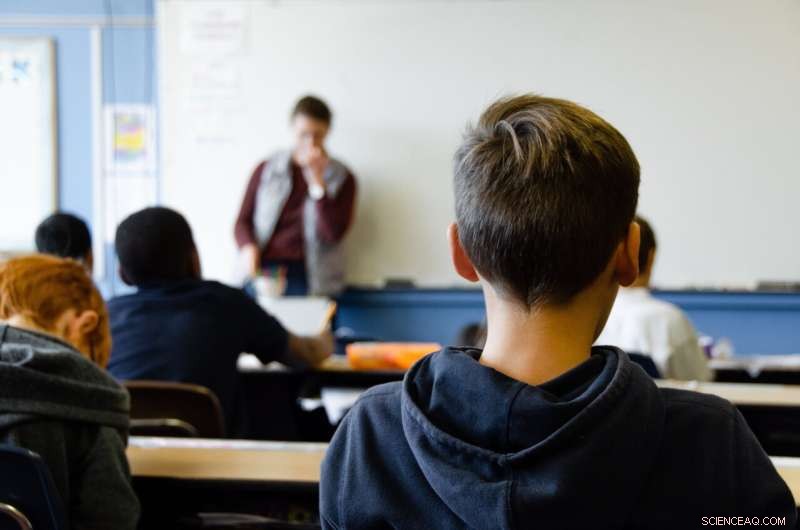
Credito:Unsplash/CC0 di dominio pubblico
Il NSW sta rivedendo il suo approccio a sospensioni ed espulsioni.
Secondo un piano proposto che dovrebbe iniziare nel quarto anno, gli studenti possono essere rimandati a casa solo un massimo di tre volte l'anno. Questo è progettato per ridurre l'elevato numero di sanzioni contro i bambini vulnerabili nelle scuole pubbliche. Ma ha incontrato l'opposizione degli insegnanti, che affermano che aumenterà i rischi per la sicurezza nella gestione degli studenti di disturbo.
Ciò avviene nel mezzo di un più ampio dibattito su come affrontare la disciplina studentesca, che continua a essere una delle questioni più difficili nelle scuole australiane. Le opinioni sul comportamento degli studenti sono diverse e spesso appassionate, con alcuni che sostengono che gli studenti dovrebbero essere "puniti".
Sfortunatamente questi punti di vista non sempre riflettono la ricerca, che mostra che approcci duri peggiorano il disimpegno degli studenti.
Cos'è l'esclusione scolastica?
Sospensioni ed espulsioni sono tradizionalmente utilizzate dalle scuole per gestire i comportamenti problematici degli studenti.
Sono dati agli studenti che interrompono il "buon ordine" delle scuole o minacciano l'incolumità degli altri. Le scuole utilizzano le sospensioni per aiutare a modificare i comportamenti improduttivi degli studenti o per consentire l'attuazione di altre strategie per evitare situazioni che si ripetono.
La durata delle sospensioni scolastiche sarà dimezzata e gli studenti non saranno rimandati a casa più di tre volte l'anno con una nuova strategia comportamentale nelle scuole pubbliche del NSW | @JordsBaker https://t.co/9KqQW1ZFqr
— The Sydney Morning Herald (@smh) 18 febbraio 2022
Le esclusioni variano in tutta l'Australia. Possono essere per un breve periodo, molto tempo o possono anche essere permanenti.
La legislazione statale e territoriale e le politiche disciplinari dipartimentali forniscono indicazioni su come le scuole dovrebbero prevenire e rispondere ai comportamenti problematici degli studenti in tutta l'Australia.
I dati recenti degli stati indicano che le esclusioni scolastiche sono in aumento. Ad esempio, nell'Australia occidentale c'è stato un nuovo massimo di 18.068 sospensioni nel 2021, con un aumento del 13% rispetto al 2020.
Cinque problemi che richiedono maggiore attenzione
Stiamo ricercando come e perché le scuole australiane utilizzano pratiche di esclusione, come le sospensioni, per gestire gli studenti disordinati.
I responsabili politici e le scuole devono prestare maggiore attenzione alle seguenti questioni quando si tratta di disciplina e comportamento.
1. Alcuni gruppi di studenti vengono sospesi più spesso
La ricerca degli ultimi tre decenni ha costantemente mostrato che le sospensioni e le espulsioni prendono di mira in modo sproporzionato studenti provenienti da contesti diversi o minoritari. Questo è particolarmente vero per le persone con disabilità o quelle provenienti da specifici background razziali, etnici e di classe.
Ad esempio, nel NSW nel 2021, mentre il 3,3% di tutti gli studenti è stato sospeso, il 10% degli studenti aborigeni e l'8,4% di tutti gli studenti con disabilità sono stati sospesi.
Questo non è solo il caso in Australia, ma anche negli Stati Uniti, nel Regno Unito e in Nuova Zelanda.
2. Non abbiamo il quadro completo
Official statistics provided by education departments offer a publicly available account as to the number of students schools have suspended and expelled from schools.
However, these figures do not always present an accurate picture. Students can be excluded from the classroom in other ways, that are not captured in official data.
For example, schools might let students remain on the school grounds for partial or full days, but not let them join their peers for lessons. This allows schools to "maintain statistical respectability."
3. What else is going on in students' lives?
Often discussions on how to manage students' behavior focus on responding to the individual's academic failure, behavior or disinterest in school. They don't look at the broader complexities of their lives.
When looking at whether suspension or exclusion is an appropriate discipline technique, schools should consider the likely impact on a child's life chances, especially for marginalized children. Will a suspension put at risk the chances of the student completing school? Will the student be supervised while they are not allowed to attend school?
Understanding how poverty and other forms of social inequality contribute to behavior in schools is important.
There are many other ways to manage students' behavior that are more supportive and can lead to more positive outcomes for the school, students and families. For example, teaching students how to manage conflict or how to manage their anger.
4. Make students feel valued
Research tells us students value schools which make trust, respect and care central to everything that happens there.
If we are going to help students connect to schooling, we need to look at the deeper causes of student disengagement. This means understanding and attending to students who feel like they do not matter or do not fit in or feel like their interests are not recognized.
This requires a commitment from schools to connect to student's lives and communities as the foundation for curriculum design and learning.
Treating teachers like professionals and giving them the time and resources to plan engaging and differentiated lessons is critical. This also involves talking and listening to what young people have to say.
5. The broader political context
Schools of course exist in a broader social and political climate. In Australia, the trend in education has been to prioritize individuals and individualism over the public good.
At the broader level, this has seen an emphasis on standards, performance and national testing.
At the micro level, this encourages schools to view problem student behaviors as the responsibility of individuals. So this means there is a focus on blaming "disruptive" students, "dud" teachers or "negligent" parents, rather than look at the influence of broader public policy settings.
So, while the NSW government is making positive steps, there is still so much more to be done to improve our approach to student discipline. + Esplora ulteriormente
Questo articolo è stato ripubblicato da The Conversation con licenza Creative Commons. Leggi l'articolo originale. 